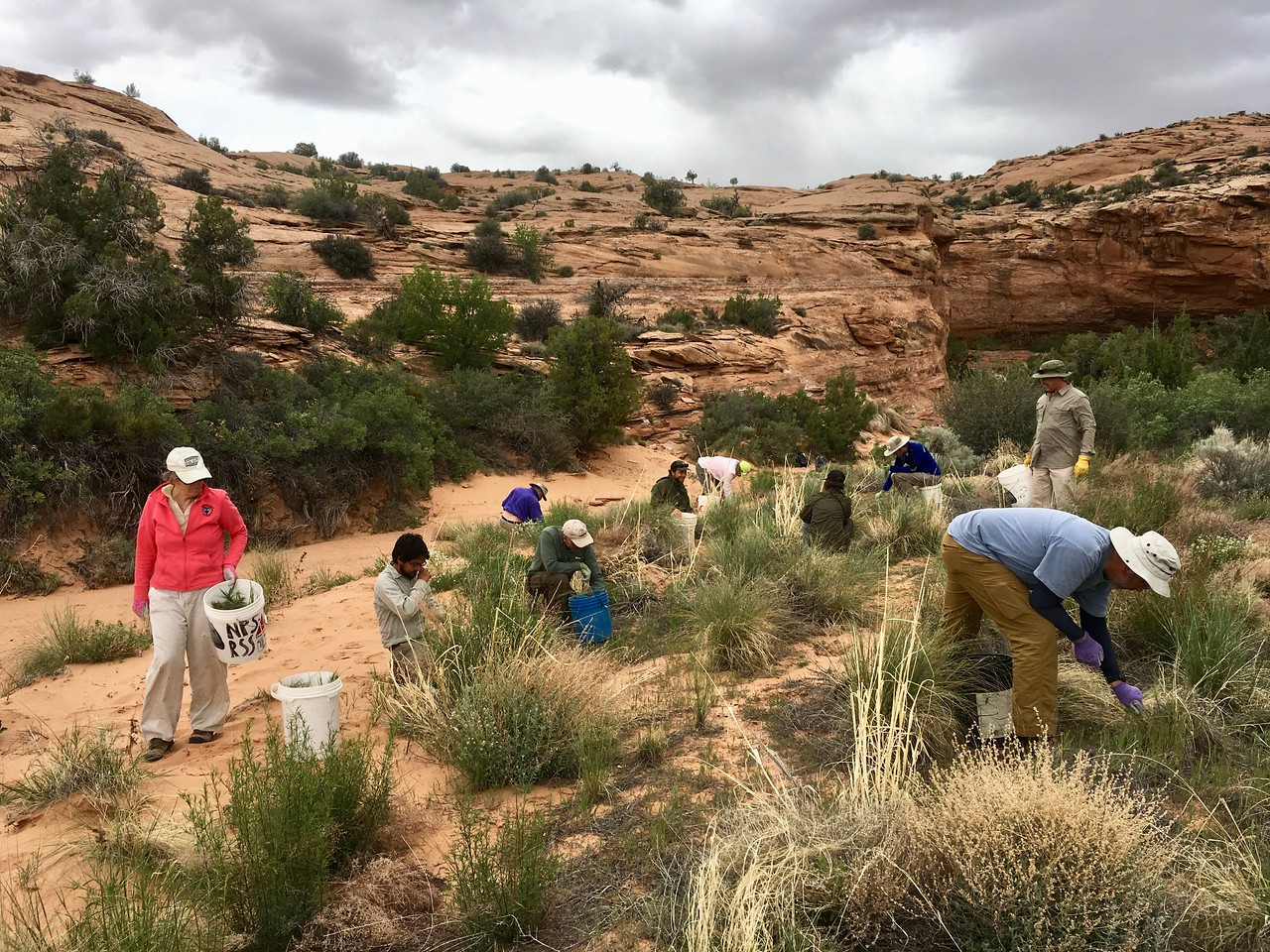Jerry Lehman first experienced Moab as a volunteer with a nonprofit called Wilderness Volunteers, working on the trail in Grandstaff Canyon in 2015. On a day off from trail work, he cycled through Arches National Park, and was moved by its beauty.
“I fell in love with the area and have been back every spring for one- or two-week long projects,” Lehman wrote in a statement. “I’ve worked on Grandstaff so many times that I’ve come to feel a sense of pride and responsibility for this fantastic accessible trail.”
Wilderness Volunteers was founded in 1997 with the mission of providing people with opportunities to contribute to the preservation of public lands. Volunteer trip leaders manage groups completing service projects, usually one week long, on public lands throughout the country, especially in the West.
Projects may include invasive plant species removal, trail-building, replacing fences, or even conducting archaeological monitoring. As the organization’s 25th anniversary approaches, its leaders are looking to expand participation and offer opportunities to more people interested in giving back to their public lands.
Projects
Land management agencies, including the Bureau of Land Management, the National Park Service, the United States Forest Service, and the United States Fish and Wildlife Service submit service project proposals to the nonprofit, which then schedules trips and fills rosters with volunteers. The organization usually completes around 45 projects a year, though in 2020, both COVID-19 and rampant wildfires caused cancellations and the group only completed 26 projects.
Agencies in the Moab area have worked with Wilderness Volunteers for years: groups from the nonprofit have worked on the Trough Springs Trail in the Canyon Rims Recreation Area managed by the Moab BLM Field Office; each year, Wilderness Volunteers work with the Forest Service in the Dark Canyon Wilderness Area; crews have also worked in Arches National Park on removing invasive species.
“In 2019 we were assisting Arches with removing invasive ripgut brome,” said Carrie Henderson, who recently took on the position of executive director of the nonprofit. Ripgut brome, a nonnative grass, can crowd out native species of plants and increase the risk of wildfire. Volunteers have helped Arches staff with invasive plant removal for four years.
The unique Dark Canyon Wilderness Area project connects Wilderness Volunteers with Forest Service archaeologists to monitor sites in a remote area near Bears Ears National Monument. The partnership has been in existence for about 20 years, and Forest Archaeologist Allison Aakre said the help of the volunteers allows agency staff to complete a much more thorough survey than they could otherwise achieve.
“That’s a really incredible one,” Henderson said.
Henderson said trips vary in intensity, rated on the organization’s website from “active” to “strenuous” to “challenging.” Groups might car-camp near their worksite, backpack in a couple of miles, or backpack up to 10 miles a day to reach sites. A “free” day is built into the seven-day schedule to allow volunteers time to relax and get to know the area where they’re working. Each trip costs $375 and includes meals and logistics; there are scholarship and sponsorship opportunities as well. The organization has also worked with students to design internships for school credit.
“Once [volunteers] go on a trip, they’re hooked for life,” Henderson said. “They go on a trip every year until they physically can’t anymore.”
The nonprofit only employs two full-time staff members; operations are carried out in large part by volunteers. Wilderness Volunteers offers a leadership training program so that devoted participants can learn to lead the trips they love. Lehman went on to become a trip leader and has worked on many projects in the Moab area.
“In addition to Grandstaff, I’ve worked on projects in Arches, Fisher Towers, Hammond Canyon, and Trough Springs Canyon,” Lehman wrote. “I’ve even had the opportunity to work with river rangers on the Colorado River. Moab is blessed with an unbelievable fantastic trail network; [Wilderness Volunteers’s] goal is always to improve it in any way we can.”
How to participate
Henderson acknowledges that the week-long format of the service projects limits the demographic of people who can participate.
“There are a lot of retired people,” she said of volunteers. “The average age for trip participants is around 60.”
As the new executive director, she hopes to establish some alternative options.
“We’re looking at a number of ways to expand our participant pool, to bring in younger folks and people from underrepresented communities and connect those folks with the outdoors,” Henderson said. She pointed out that many professionals have shifted to remote or flexible-schedule work models since the pandemic began, which may allow for participation in a volunteer service project—especially if the organization moves to offer three- or four-day trips in addition to full seven-day trips.
The nonprofit provides needed labor to land management agencies to complete critical projects, but it also offers opportunities for growth to participants. Linda Ziesmer started working with Wilderness Volunteers in 2006 and has participated in about 25 projects.
“The opportunity to ‘give something back’ has been extremely rewarding and personally fulfilling,” Ziesmer wrote in a statement about her work with Wilderness Volunteers. “It has enabled me to travel all across the country and experience more awe-inspiring landscapes than I can put into words.”
Ziesmer is now a volunteer trip leader and visited Moab for the first time while serving in that role for a project in Arches National Park.
“One gorgeous vista after another blew me away and the night skies put everything in peaceful perspective,” Ziesmer wrote of her experience in Arches.
“We’re looking at a number of ways to expand our participant pool, to bring in younger folks and people from underrepresented communities and connect those folks with the outdoors.” -Carrie Henderson




